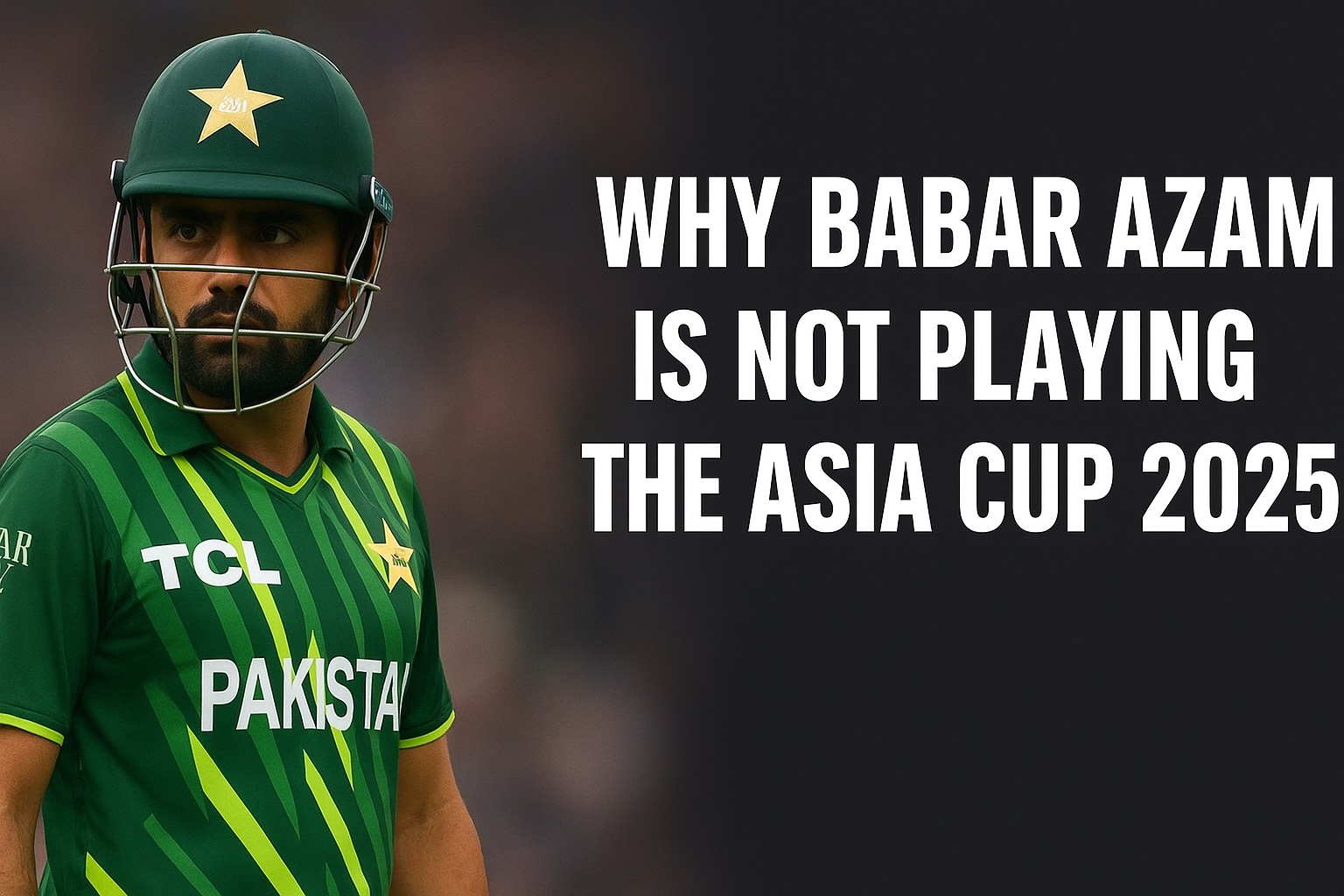Why is Babar Azam not playing the Asia Cup 2025? Pakistan’s star batter has been left out due to his recent dip in T20 form, low strike rate, and team management’s shift toward younger power hitters. Read the full story with insights on team selection, fan reactions, and what’s next for Babar.

Introduction
Babar Azam has been Pakistan’s batting superstar for nearly a decade. From classy cover drives to match-winning innings, he has carried the team through countless big moments. Yet, as surprising as it may sound, Babar Azam is not playing the Asia Cup 2025.
This decision shocked millions of fans across Pakistan and cricket lovers worldwide. But behind the headlines lies a deeper story, a mix of recent form, team strategy, and the changing face of modern T20 cricket.
In this article, we’ll break down the reasons why Babar Azam is not part of the Asia Cup 2025 squad, what it means for Pakistan’s campaign, and whether this is a temporary setback or the beginning of a new phase in his career.
Recent Dip in T20 Form
Low Strike Rate Concerns
One of the primary reasons why Babar Azam is not playing the Asia Cup 2025 is his declining strike rate in T20 internationals. While his batting average has remained respectable, T20 cricket is now about scoring quickly, not just consistently.
- In the recent series, Babar struggled to accelerate in the power play.
- His strike rate often hovered around 115–120, while modern T20 openers average above 135–140.
- In matches where Pakistan needed fast starts, his style sometimes put pressure on the middle order.
Selectors felt that in a tournament like the Asia Cup, where India, Sri Lanka, and even Afghanistan Show off aggressive openers, Pakistan needed explosive hitters up front rather than anchor-style batters.
Team Management’s New Direction
Focus on Power Hitters
Pakistan’s new selection committee has highlighted power hitting as the key to success in T20 cricket. The squad for the Asia Cup 2025 includes younger batters who can clear the ropes from the first ball.
Babar’s elegant batting style remains valuable in ODIs and Tests, but in T20s, the management believes in giving more opportunities to:
- Fakhar Zaman – A proven match-winner at the top.
- Saim Ayub – A rising star with natural big-hitting skills.
- Hassan Nawaz – Providing finishing power in the middle order.
This reflects a shift in strategy, prioritizing strike rate over stability.
Leadership and Pressure Factor
Babar has carried the dual role of star batter and captain for many years. While he stepped down from captaincy in some formats earlier, the pressure of expectations has clearly weighed on his shoulders.
Selectors want to reduce this burden and allow him to rebuild his T20 game without the constant spotlight. Suryakumar Yadav’s India, for example, plays fearless cricket. Pakistan hopes to replicate that by building a younger squad that does not rely heavily on one senior star.
Fan Reactions
The news that Babar Azam is not playing the Asia Cup 2025 has divided fans:
- Supporters argue he is still Pakistan’s best batter and should not be dropped for a big tournament.
- Critics believe the move was necessary to rebuild Pakistan’s T20 approach.
Social media has been buzzing with hashtags like #BringBackBabar and #PakCricketFuture. No doubt, this is one of the most debated decisions in Pakistan’s cricket history.
Possible Reasons Beyond Form
While the official explanation centers around his T20 strike rate, there may be other contributing factors:
- Rest and workload management – With long tours and back-to-back ICC events, Babar might be given a break.
- Experimenting with combinations – Pakistan wants to test its bench strength before the ICC T20 World Cup 2026.
- Personal form correction – Time away from international T20s could help Babar rework his approach and return stronger.
What This Means for Pakistan in the Asia Cup 2025
Without Babar, Pakistan’s batting order looks different:
- Fakhar Zaman
- Saim Ayub
- Sahibzada Farhan
- Salman Ali Agha (Captain)
- Hassan Nawaz
- Mohammad Nawaz
This is a more aggressive lineup, but it lacks the calm anchor role that Babar often provided. If early wickets fall, Pakistan might struggle to stabilize the innings. On the other hand, if this strategy clicks, Pakistan could dominate power plays like never before.
Babar Azam’s Future in T20 Cricket
The big question is: Is this the end of Babar Azam’s T20 career?
Most likely, no.
- Babar is still just 30 years old in 2025.
- He remains one of the best ODI and Test batters in the world.
- A break could revive his hunger to adapt his T20 style.
If he works on increasing his strike rate and adds more power-hitting options to his game, a comeback before the T20 World Cup 2026 is very possible.
A Look at Past Legends Dropped from Big Tournaments
History shows that even the greatest players have been sidelined at times:
- Virat Kohli faced questions about his T20 strike rate in 2022.
- MS Dhoni eventually stepped away when India needed fresh leadership.
- Kumar Sangakkara and Mahela Jayawardene adapted their roles before retirement.
For Babar, this could simply be a phase of transition rather than a permanent exclusion.
Conclusion
So, why is Babar Azam not playing the Asia Cup 2025? The answer lies in a mix of cricketing form, strategic decisions by selectors, and the evolving nature of T20 cricket. His low strike rate in recent matches was the main trigger, but it also reflects Pakistan’s attempt to embrace a more fearless batting style.
For fans, it is heartbreaking not to see Pakistan’s most elegant batter in action. But for Babar himself, this could be the perfect opportunity to refine his game, take a mental reset, and come back stronger.
One thing is certain: Babar Azam’s story in T20 cricket is far from over.

